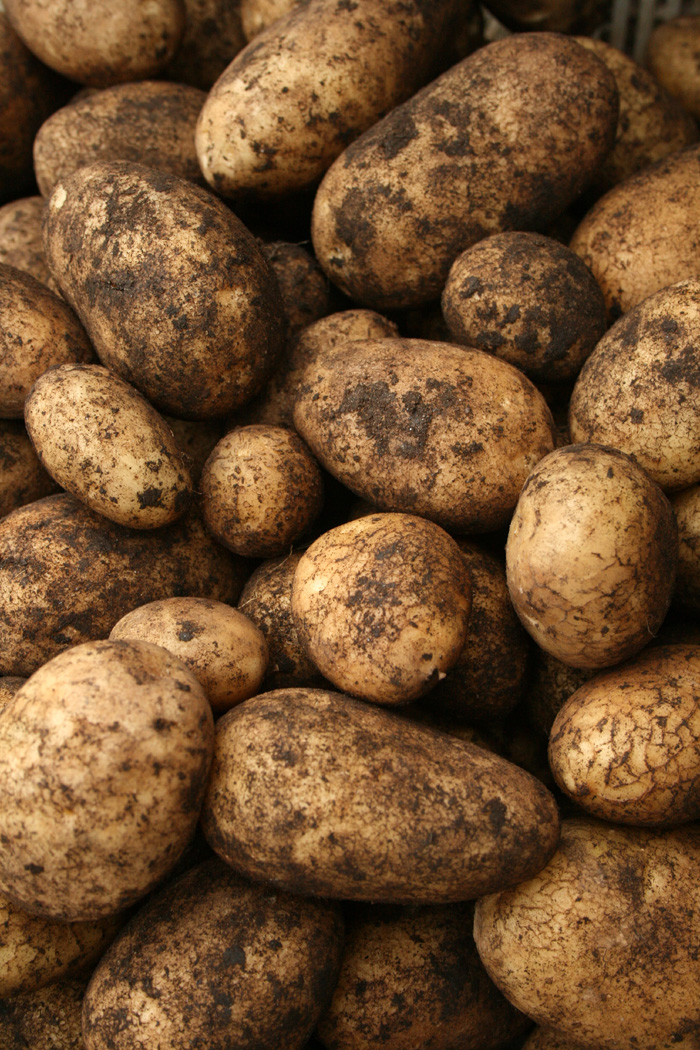
December 9, 2011
A recipe from Masterchef presenter Gregg Wallace, shown in the BBC’s recent Great British Food Revival series.
Serves 4
Preparation and cooking: 30-40 minutes
Ingredients
For the gnocchi:
300g floury potatoes
50g plain flour, plus extra for dusting
For tomato sauce:
1-2 tbsp olive oil
1 small onion, finely chopped
1 garlic clove, finely chopped1 tbsp tomato purée
1 x 400g can chopped tomatoes
pinch of sugar
salt and freshly ground black pepperbasil leaves, to garnish
Method
For the gnocchi, cook the potatoes in their skins in a pan of boiling water for 10-15 minutes, or until tender (a knife should slide in without much resistance). Drain the potatoes and set aside until cool enough to handle. Peel the potatoes and pass through a potato ricer into a bowl, then measure out 250g for the gnocchi.
For the tomato sauce, heat the olive oil in a small pan and gently fry the onion and garlic for 2-3 minutes, or until softened but not coloured. Add the tomato purée and chopped tomatoes and bring to a simmer. Reduce the heat slightly and cook for a further 10-15 minutes, stirring occasionally. Season with a pinch of sugar and some salt and freshly ground black pepper.
Meanwhile, tip the potato onto a floured work surface and knead in the flour until the mixture comes together to form a dough. Divide into four equal pieces and roll out into thick sausage shapes. Cut each sausage into 2cm/1in pieces and press with the tines of a fork to create a pattern.
Bring a large pot of salted water to the boil and add the gnocchi. Cook the gnocchi for 1-2 minutes, or until they float to the top. Remove with a slotted spoon and divide among serving bowls.
Spoon over the tomato sauce and garnish with fresh basil to serve.

December 8, 2011
This week everyone will have:
potatoes (Burlerrow Farm, St Mabyn)
* onions (Camel CSA)
* salad bag (Camel CSA)
* sprout stalk (Camel CSA) – do use the tasty top too!
* carrots (Camel CSA)
* leeks (Camel CSA)
* turnip bunch (Camel CSA)
Standard boxes will have extra potatoes plus
* parsley (Camel CSA)
* purple sprouting broccoli/swiss chard (Camel CSA)
* beetroot bunch (Camel CSA)
* = grown to organic principles
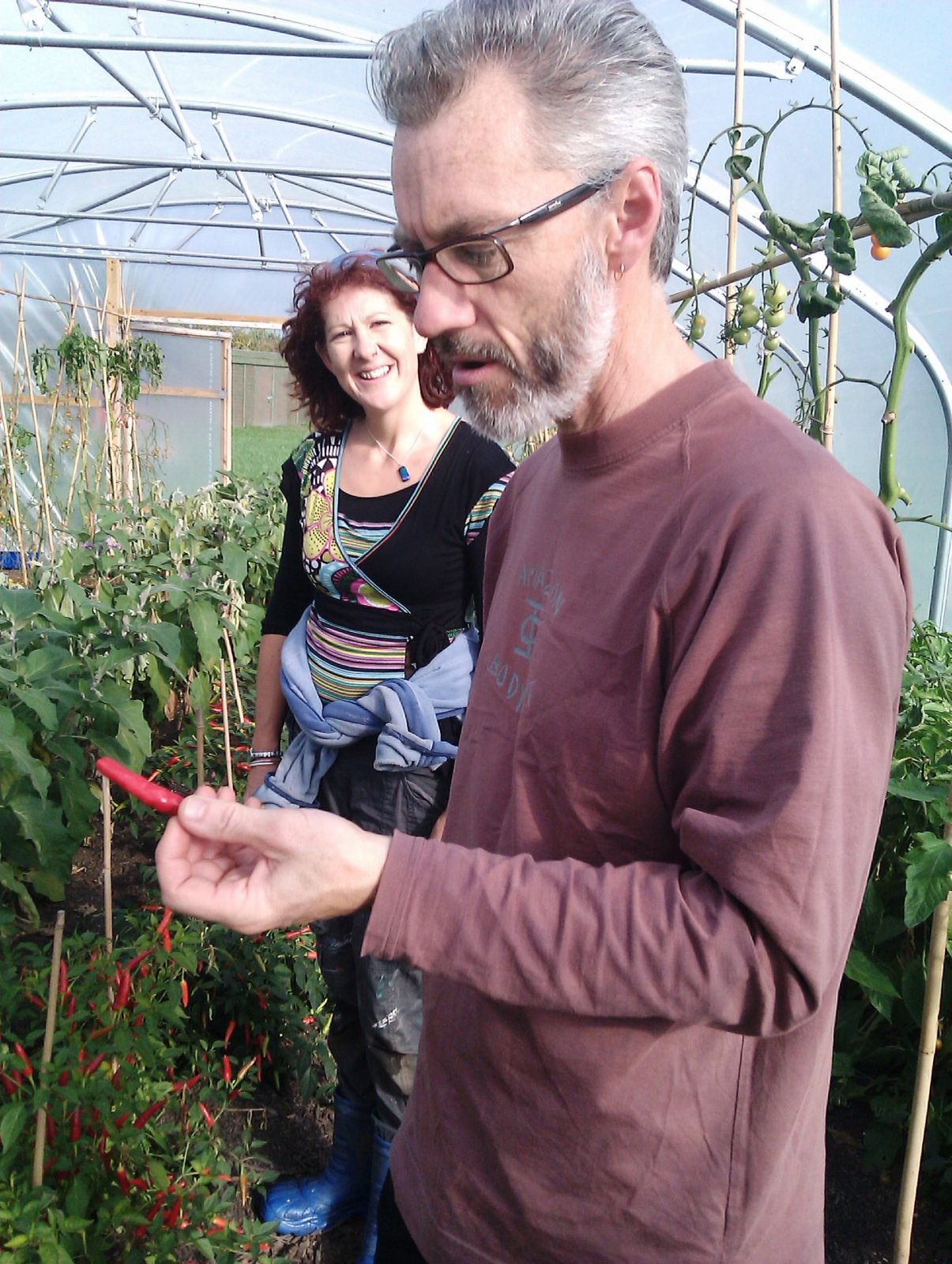
December 4, 2011
Camel CSA’s vegetable boxes have been overflowing with a surplus of produce for months now.
All kinds of chutneys and preserves have been made from the veg gluts, but we’ve been almost defeated by the enormous surplus of chillies cultivated in our second polytunnel.
The problem with chillies is that a little goes a very long way.
They feature regularly in our weekly vegetable boxes. Volunteer veg packer Henrietta has made some into chilli jam. Volunteer grower Mark M (who loves to crunch them up raw) pickled some chillies in vinegar. Membership secretary Cath experimented with chilli oil.
All these culinary enterprises proved extremely expensive and time-consuming. I still have hundreds – no thousands – of chillies drying out slowly on the laundry rack above my boiler at home.
Enter now the artistic wing of our food-growing social enterprise.
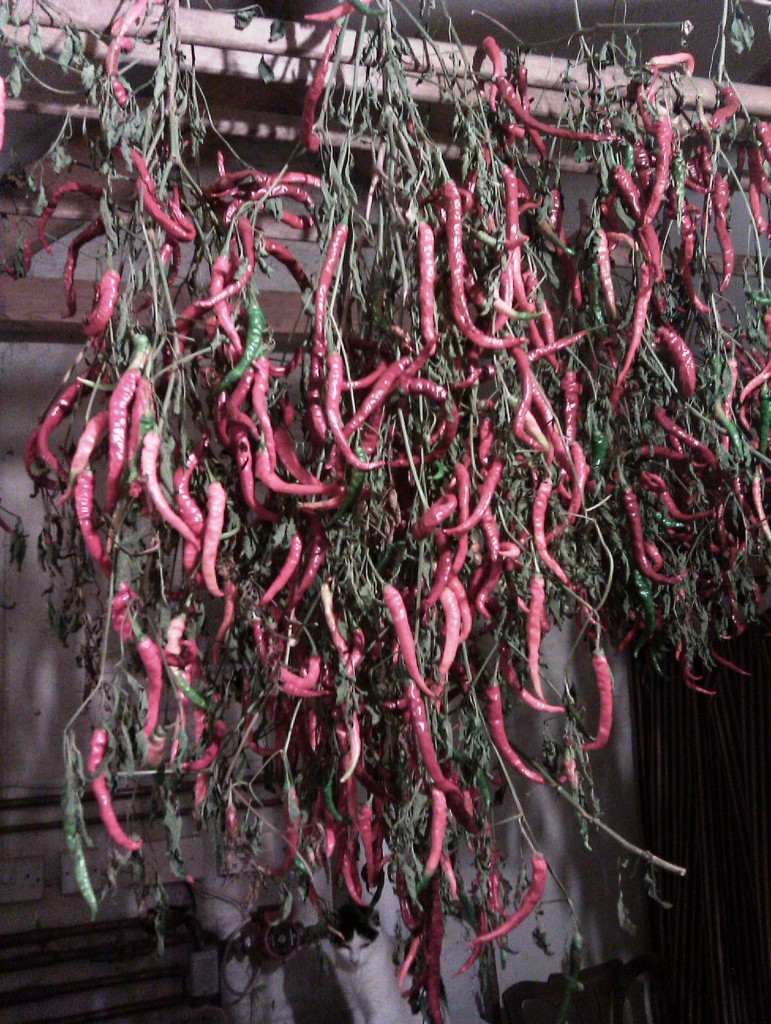
The latest plan is to turn the chilli surplus into natural edible garlands to go in our Christmas veg boxes. After the festivities are over, the chillies can be plucked from the decorative string and used in cooking.
We’re holding a chilli stringing evening this coming week, when the hundreds of chillis will be threaded on to fishing line. We’re supplying the wine, the chillies, the materials and the surgical gloves(!) Camel CSA members are providing the labour.
I’m amazed at what people charge for hot chilli garlands, centrepieces and edible chilli and herb garlands, so I’ll be interested to see how many we can string together in just one evening!
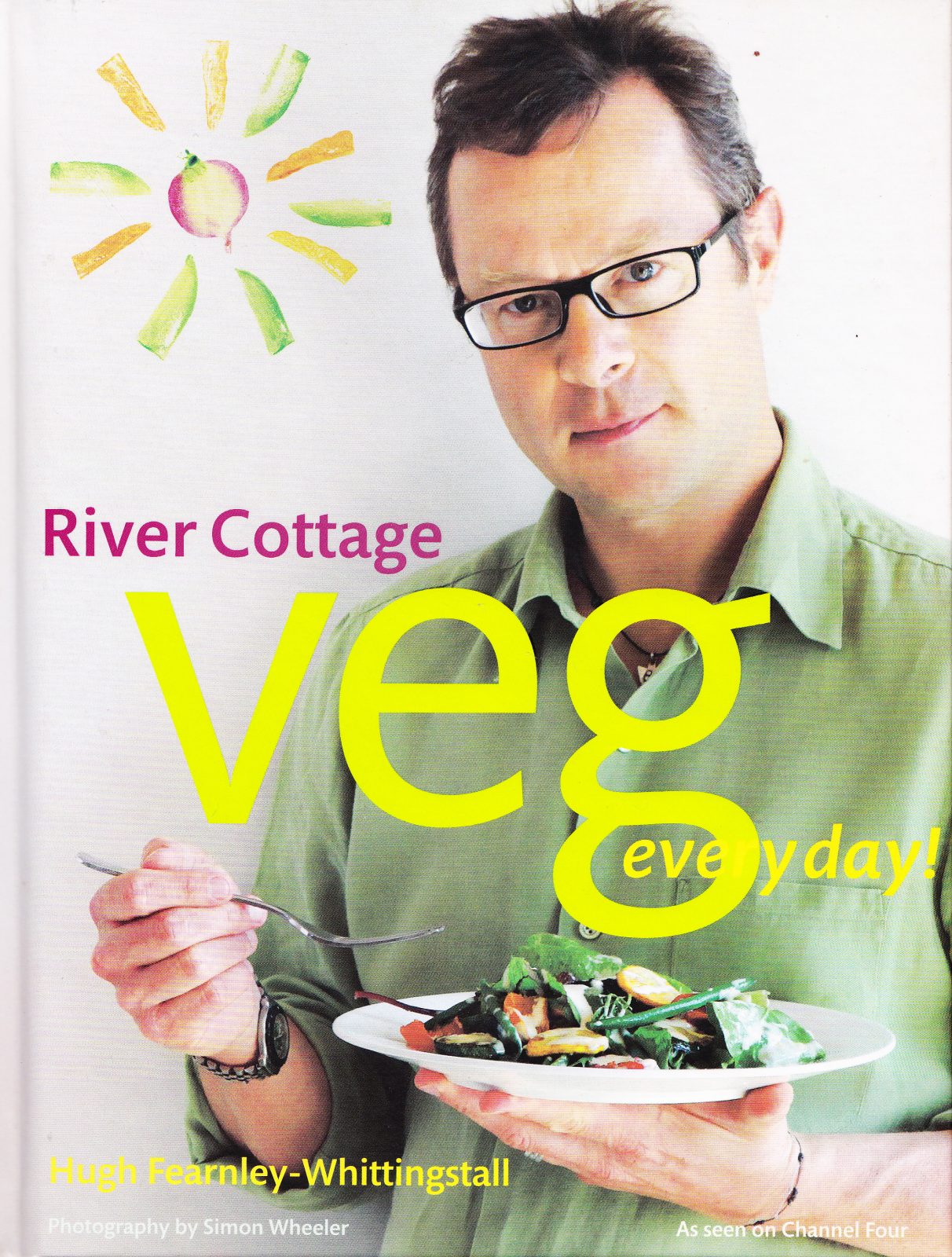
December 2, 2011
With a selection of roots in our boxes this week – and with the weather getting colder – it seems a good idea to try this ‘comfort food’ recipe from Hugh Fearnley-Whittingstall’s River Cottage Veg Every Day. He says that while it’s not exactly ‘light’, it’s certainly less rich than a creamy dauphinoise-style gratin.
You could also substitute other seasonal roots such as Jerusalem artichokes, carrots or swede which would all work well. Good served with some big flat field mushrooms simply baked with some butter, garlic and cheese, and some good bread.
Serves 4
Preparation: 20 minutes
Cooking: about an hour
Ingredients
30g butter
2 onions, halved and sliced
2 garlic cloves, sliced
1 small celeriac
2 large potatoes
3 large parsnips
a couple of sprigs of thyme, leaves only, chopped
3 sage leaves, finely chopped
about 1.2 litres vegetable stock
sea salt and freshly ground black pepper
Method
Preheat the oven the 180C/gas 4. Melt the butter in a heavy-bottomed frying pan and use some of it to grease a large gratin dish. Add the onions to the pan and sauté over a medium heat for about 10 minutes, until soft, then add the garlic and cook gently for a further minute or two.
Meanwhile, peel the celeriac, potatoes and parsnips and cut into slices the thickness of a 10p piece, slicing the parsnips lengthways. Spread out the celeriac in the gratin dish, season generously with salt and pepper, then sprinkle with half the onions and half the herbs. Layer the parsnips on top, then scatter the remaining onions and herbs on top and finish with a layer of potatoes.
Bring the stock to a simmer and add some salt and pepper, then pour over the vegetables to barely cover them (you may not need all of it). Cover the dish with foil and bake for 30 minutes, then uncover and continue to bake for another 30 minutes or so until the vegetables are cooked.
At this point, if there is still liquid covering the potatoes, spoon off a little and return the dish to the oven for 15 minutes or so, to brown the potatoes on the top. Serve piping hot.
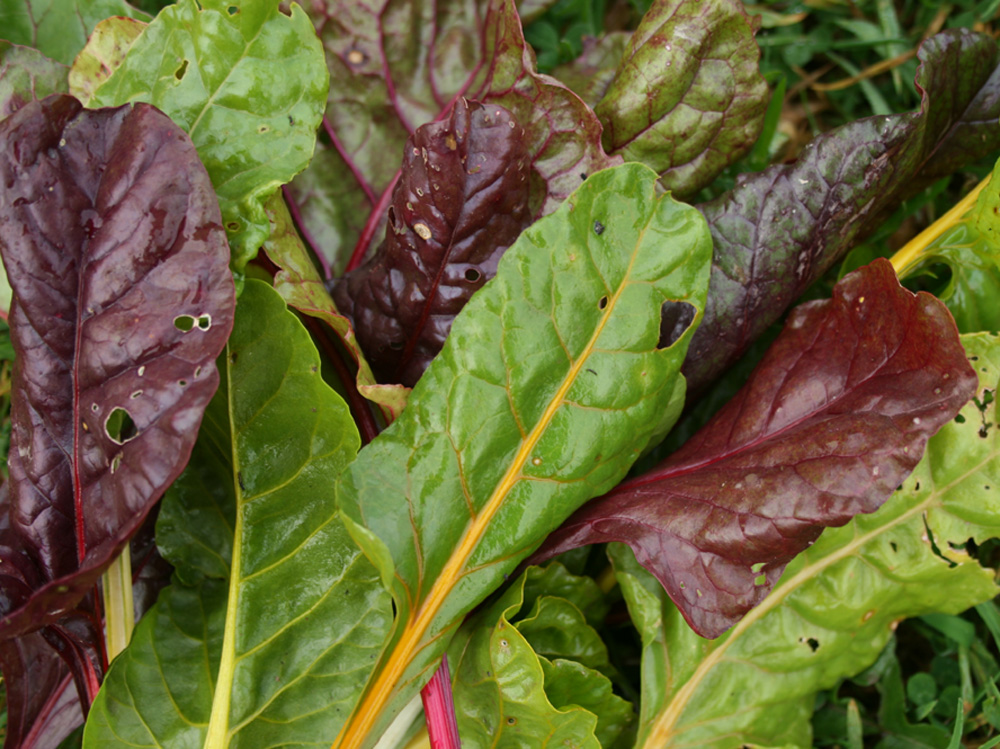
November 30, 2011
This week everyone will have:
potatoes ((Burlerrow Farm, St Mabyn)
* garlic (Camel CSA)
* onions (Camel CSA)
* salad bag (Camel CSA)
* carrots (Camel CSA)
* celeriac (Camel CSA)
* swiss chard (Camel CSA)
* squash (Camel CSA)
Standard boxes will have extra potatoes plus:
* swede (Camel CSA)
* parsnips (Camel CSA)
* purple sprouting broccoli or red cabbage (Camel CSA)
* = grown to organic principles

Now I know why oriental salad leaves are so expensive in the supermarkets!
We’re cultivating an assortment of indoor-grown oriental and other baby leaves in our first polytunnel.
These “cut and come again” crops should last us until early spring (with a gap when they stop for a rest in the short, dull days of mid-winter).
There’s quite a variety – spicy red mustard, mizuna and mibuna, pak choi, curly endive, baby chard, parsley (“French” flat as well as curly-leaved) and mixed lettuce.
But it takes two or more people around two hours every Friday morning to pick enough leaves for the 35 or more weekly vegetable boxes. It requires nimble fingers and is incredibly labour intensive.
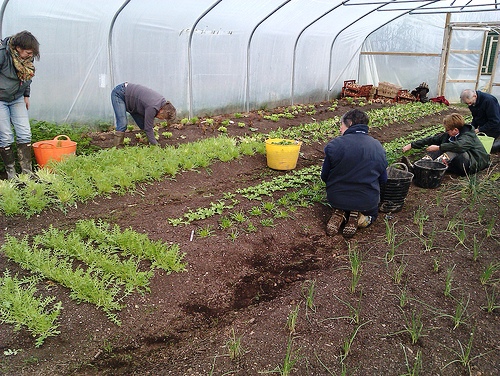
There’s one big mitigating factor about all this for the volunteer pickers. Salad leaf picking is guaranteed warm, dry work which is also out of the wind.
Arguably much more satisfactory than parsnip, leek or carrot lifting which are cold, wet and muddy jobs.

November 25, 2011
Another British cookery classic – this time from the late Jane Grigson. This was one of her favourite recipes and tastes all the better the day after you make it.
Her daughter Sophie Grigson is carrying on the tradition and makes this soup too. For the carnivores among you – it does bring out the flavour if you use beef stock, rather than chicken or vegetable.
You can substitute the freshly-ground spice mixture with a half tablespoon of curry powder or curry paste, but it’s not nearly as good as the real thing. I use creme fraiche rather than whipping cream.
Serves: 4
Preparation: 20 minutes
Cooking time: 30 minutes
Ingredients
1 medium sized onion
1 large clove of garlic, halved
1 large parsnip, peeled and cut into chunks
45 g butter
1 tbsp plain flour
A pinch of black pepper
1 litre beef stock (or chicken or vegetable stock)
150 ml whipping cream
A handful of chopped chives or parsley
For the spice mixture:
1 tbsp coriander seeds
1 tsp cumin seeds
0.25 tsp fenugreek seeds
0.5 tsp dried red chilli flakes
1 tsp turmeric
Method
To make the spice mix, dry fry the first three spices in a small, heavy frying pan over a moderate heat until toasted and aromatic. Tip into a bowl and leave to cool, and then grind to a powder with the chilli and turmeric. Store in an airtight jar.
Sweat the onion, garlic and parsnip gently in the butter, with the lid on the pan, for 10 minutes. Stir in the flour and a tablespoon of the spice blend, plus a little salt. Cook for 2 more minutes, stirring occasionally.
Pour in the stock, gradually. Bring up to the boil and simmer for about 15-20 minutes until the parsnip is very tender.
Liquidise the mixture, adding water or more stock if you have any to hand, until he soup has a similar consistency to double cream. Taste and correct the seasoning.
Reheat when needed, stir in the cream and serve scattered with chives or parsley.
- More parsnip recipes from Camel CSA

November 24, 2011
This week everyone will have:
potatoes (Burlerrow Farm, St Mabyn)
* onions (Camel CSA)
* salad bag (Camel CSA) **
* parsnips (Camel CSA)
* leeks (Camel CSA)
* savoy cabbage (Camel CSA)
* carrots (Camel CSA)
* turnip bunch (Camel CSA)
Standard boxes will have extra potatoes plus:
* beetroot bunch (Camel CSA)
* jerusalem artichokes (Camel CSA)
* purple sprouting broccoli or swiss chard (Camel CSA)
* = grown to organic principles
** The salad bags contain pak choi, curly endive, mibuna, mizuna, baby chard and red mustard leaves

November 16, 2011
Everyone will have:
potatoes (Burlerrow Farm, St Mabyn)
* garlic (Camel CSA)
* onions (Camel CSA)
* salad bag of mixed winter leaves (Camel CSA)**
* squash (Camel CSA)
* carrots (Camel CSA)
* swede (Camel CSA)
* swiss chard (Camel CSA)
Standard boxes will have extra potatoes plus:
* celeriac (Camel CSA)
* beetroot (Camel CSA)
* sprouting broccoli and/or kale depending on amount of broccoli available (Camel CSA)
* = grown to organic principles
** The salad bags contain mixed lettuce, red mustard, pak choi, mizuna, mibuna, baby chard and curly endive leaves.
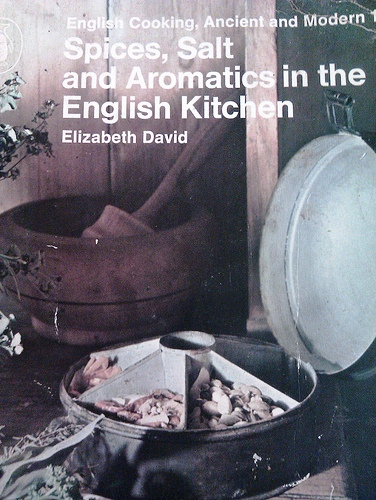
November 11, 2011
Mincemeat? A recipe for mincemeat? In a vegetable box?
The best homemade Christmas mincemeat recipe I’ve ever tasted is one of the simplest. It comes from my stained and much-thumbed edition of a cookery classic – Elizabeth David’s Spices, Salt and Aromatics in the English Kitchen. It’s easy to make – an assembly job really – and is a thousand times better than the sickly, glace-cherry-studded supermarket versions.
I’ve come to the conclusion that the secret of her method, which was passed on to her by a friend (the best recipes always are!), is the generous amount of chopped apple which adds chewy moistness and a delicious tang.
So why not use the apples in Camel CSA’s veg boxes this week?
Elizabeth David made her mincemeat with shredded beef suet of course, in the traditional manner, but I find that vegetarian suet does just as well. Use light or dark brown sugar – I like dark muscovado.
Make this mincemeat at least two weeks before you want to use it, to allow the flavours to mingle. This amount makes approximately six decent-sized jars. If you want less, just halve the ingredients.
It normally gets used up pretty quickly in this household, but I have kept jars of it for up to two years in the fridge. An additional splash of brandy helps.
Preparation: up to an hour
Cooking: none
Ingredients
800g sharp apples
350g raisins
350g currants
350g sultanas
350g shredded suet (vegetarian if you prefer)
350g soft brown sugar
100g mixed peel
50g skinned and coarsely chopped almonds
Half a teaspoon each of grated nutmeg, cinnamon and mace
Grated rind and juice of one lemon and one orange
75ml brandy, rum or whisky
Method
Dice the peeled and carefully cored apples. Mix all the ingredients together, adding the alcohol last. Leave the mixture to steep in a cool place for 24 hours, to allow the flavours to mingle.
Fill glass or stoneware jars that you have sterilised first – either by putting them through the dishwasher on a hot cycle or washing by hand and drying them in a low oven (but make sure they’ve cooled down before you fill them). Use screw lids or clip-on tops and store in a cool place.
.


